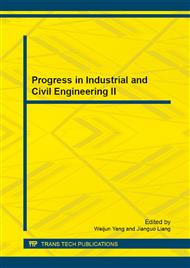p.418
p.422
p.428
p.434
p.437
p.441
p.445
p.450
p.454
Model Testing for Two Sides Vertical Anchored High Road Dyke of Reinforced Backfilled Retailing Wall
Abstract:
The aim of this research is to better understand the behavior of reinforced structures of two sides vertical anchored block backfill reinforced retaining wall. A vertical model retaining wall, 3m high and 5m long, which was constructed by reinforced backfill using two sides vertical anchored blocks. The results showed that the maximum lateral wall displacements increased almost in the middle of the wall height with a maximum value above the wall base. The measured earth pressures showed that the horizontal earth pressures exerted on the wall facing are greater than those inferred from the Rankine active state up the 1/3H of the wall and are lesser than those inferred from the Rankine active state under the1/3h of the wall. The measured and the calculated displacements of wall show very encouraging agreement although the deformation was slightly over predicted at the top and bottom of the wall.
Info:
Periodical:
Pages:
437-440
Citation:
Online since:
September 2013
Authors:
Price:
Сopyright:
© 2013 Trans Tech Publications Ltd. All Rights Reserved
Share:
Citation:


